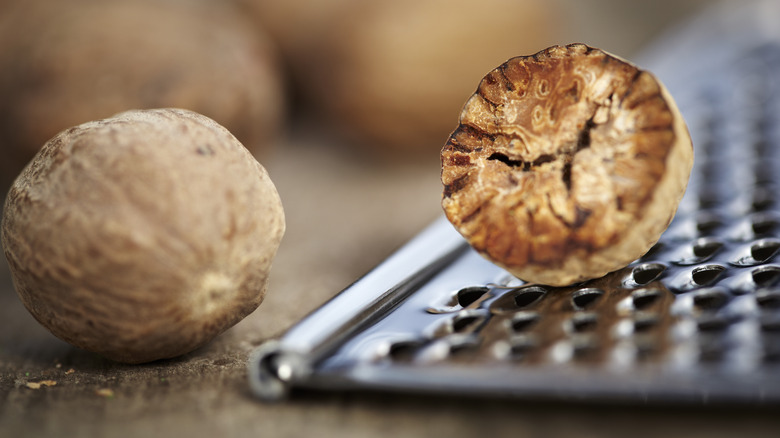What You Should Know When Using Ground Vs Whole Nutmeg
If you've ever sipped a glass of eggnog and wondered about its fragrant warming spices, you were likely ruminating on nutmeg. This spice, native to the nutmeg trees of Indonesia, has a distinct similarity to the peppery mace, which actually comes from the coating of a nutmeg seed. Nutmeg has a bold taste that is simultaneously sweet, nutty, and spicy. You can purchase nutmeg either as a whole seed or ground into a powder, both of which have an array of different cooking applications. As is typical with most spices, grating nutmeg from a whole seed has a higher potency than pre-packaged versions of the ground spice.
The main difference between ground and whole nutmeg is the strength of flavor. The essence of a container of powdered nutmeg will begin to fade after opening, while a whole nutmeg seed can keep indefinitely with proper storage. You can determine which iteration to use based on the impact you need from your seasonings. For example, you will get more of a kick in ¼ teaspoon of freshly ground nutmeg than in a whole teaspoon of pre-ground nutmeg. Consider when adding nutmeg to enrich your Alfredo sauce that, while ground nutmeg may be more conveniently on hand, you would need only a fraction microplaned from a nutmeg seed directly into your dish.
Necessary nutmeg tips
Whether you use ground or whole nutmeg, it is vital to store both in an airtight container in a cool, dark place to preserve the flavor. Careful measuring of both whole and ground spices is essential to ensure you don't over-season your food. There is, in fact, such a thing as having too much nutmeg, which although rare, can cause intoxication in significantly large amounts. When using a microplane or dedicated nutmeg grater, take precautions such as using a food guard or cut-resistant gloves to save your fingers from the incredibly sharp, small blades. You can also set time aside to grate and store your own fresh nutmeg powder for a pre-ground seasoning with a higher potency and longer shelf-life.
Different dishes to which you can add the warming aroma of nutmeg include vegetables, such as creamed collard greens. This will give the classic dish extra complexity while complementing the dairy element, as with Alfredo and béchamel sauce. Nutmeg is also a star component of any traditional pumpkin pie spice blend and a bevy of warming seasonal beverages. Getting more experimental, you can try using it to boost the flavor of a quiche. However you choose to infuse nutmeg into your cooking, remember that a little bit goes a long way.

